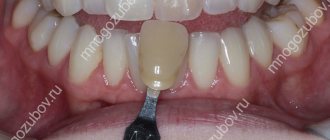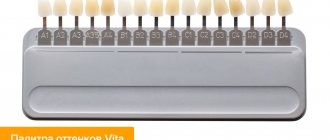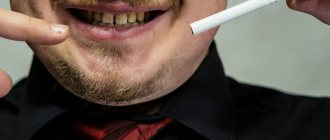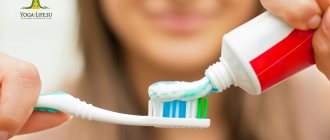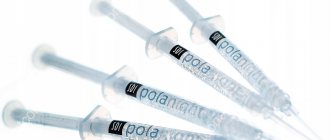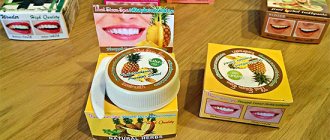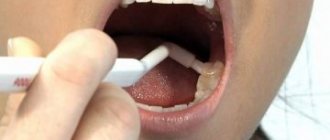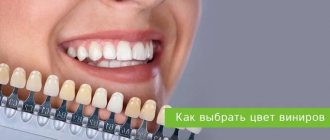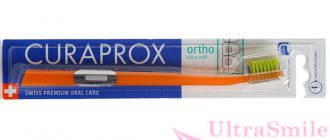Our enamel is constantly exposed to aggressive external factors, such as coloring products, coffee and tea, medications, and tobacco smoke. All this over time leads to a gradual change in the color of the teeth, the formation of abundant yellow plaque, which over time turns into hardened deposits that provoke the development of caries. Today, the Vita tooth color scale is actively used in dentistry - it is used to determine the shade of enamel, predict the results of whitening, and select the appropriate tone for filling materials. Later in this article we will talk about what this scale is, when it is used and how to use it correctly.
What factors determine the natural color of enamel?
Before moving on to the technique of using the Vita scale in dentistry, let’s consider what the natural shade of teeth depends on and what affects their color. Several factors play a decisive role in this issue, and here are the main ones:
- heredity,
- predisposition to certain systemic pathologies,
- level of hygiene,
- diet,
- condition and strength of bone tissue.
If we talk about what tone of teeth is considered normal, then we must immediately make a reservation that the enamel consists of approximately 97% of inorganic compounds. Therefore, its natural color is different for everyone, despite the fact that a person may not have any pronounced dental problems.
Heredity primarily determines the color of teeth
A change in the color of the enamel, its yellowing should be a good reason for concern and contact a specialist. After all, poor hygiene and plaque are not the only reasons for visible changes, and the real problem may lie much deeper. The reason may be not only dental disease, but also systemic pathologies.
How the scale is used, subtleties of application
When conducting a comparative analysis, the dentist takes into account a large number of nuances. The assessment result is influenced by subjective factors that vary depending on lighting, the patient’s skin tone, and the general condition of the oral cavity.
The Vita tooth color scale is used to compare the color of different areas of the jaw structure. This is due to differences in the thickness of dentin tissue or enamel coating, uneven home cleaning, and the onset of the pathological process.
The dentist takes 3 measurements - near the gum bed, at the upper edge, in the central part of the tooth. Compare the shade on the front and back surfaces of the jaw element.
When an analysis is performed to make a denture, the results are sent to a dental laboratory. Designs are selected using a reference sample with the specified code - A2, C3 and so on.
When using a scale for laser or chemical whitening, the results obtained are compared during the process in order to achieve the most natural appearance of the oral cavity.
For what reasons can the shade of teeth change?
A naturally perfect snow-white smile is quite rare. In addition to the fact that most people’s teeth have a slight yellowish tint from birth, throughout their lives they are constantly exposed to external factors that cause their color to change. Here are just the main prerequisites:
- improper and irregular cleaning,
- addiction to coffee, strong tea and other coloring drinks,
- smoking cigarettes,
- aging of the body,
- dental diseases,
- consumption of products with intense coloring pigments,
- lack of vitamins and microelements or their excess in the body,
- taking certain medications.
Constant exposure to external factors causes changes in the color of teeth
. To maintain the natural whiteness of a smile, you need to follow the rules of oral hygiene, respond in time to any suspicious changes, and regularly visit the dentist’s office for preventive examinations.
What color is considered normal for a milk bite?
Baby or primary teeth in children are usually whiter than permanent teeth in adults. This color comes from thinner enamel than permanent crowns. If the milk crowns have a yellowish or grayish tint, then this indicates their disease or a metabolic disorder in the body.
The method of returning the natural shade to temporary units depends on the reasons for its change. Sometimes it is enough to exclude certain foods from the diet and start filtering the water, and the color of the crowns will gradually be restored. If the change in enamel color is caused by a disease, then it is important to establish a diagnosis and select adequate treatment.
Vita scale - what is it?
The Vita scale is a ruler of visual perception of different shades of enamel, in which each tone is assigned an alphanumeric designation. This table is the most popular tool for determining the color of teeth in dentistry both in Russia and in European countries. The scale itself is divided into 4 groups: A, B, C and D. The palette includes 16 shades. As part of professional whitening or prosthetics, the specialist first evaluates the current clinical picture, after which he selects the closest shade from the proposed range.
On a note! In modern clinics, digital technologies are used for this purpose, for example, the Digital Smile Design program. This is innovative software that allows you to project the appearance of your smile after restoration and carefully plan the upcoming treatment, including determining the most suitable enamel tone. Images of the patient’s jaw system from different angles are loaded into the program, where they are further processed and the future smile is modeled.
The Vita scale can be presented in the form of a palette printed on thick laminated cardboard, plastic or paper. But the best option is a table with retractable acrylic microprostheses made of ceramics. This device is used when choosing the color of a composite material for artistic restoration, the shade of a future crown, in the manufacture of veneers and lumineers, and for whitening.
Thus, the scale offers the following palette of tones:
- A (1, 2, 3, 3.5, 4) – five options of red-brown shade,
- B (1, 2, 3, 4) – four subtones of red-yellow,
- C (1, 2, 3, 4) – four shades of gray,
- D (2, 3, 4) – three subtones of red-gray1.
The Vita scale can be presented in the form of a palette
Now about brightness: the higher the index, the dimmer the color. The lower it is, the lighter and brighter the samples will be. So, for example, under the designation A1 will be the lightest shade, while under A4 will be the darkest shade from this category.
Tone selection features
When contacting dentists regarding prosthetics and teeth whitening, it is strongly recommended to conduct a comparative analysis using the classic Vita colors. The most popular today are instruments manufactured by the manufacturer Ivoclar Vivadent (Liechtenstein), the slats of which include the lightest shades from groups A, B, C and D, called Bleach. The average cost of one such palette is about 1,400 Russian rubles.
Instead of such a device, computer technologies can be used, which can also be used to select the optimal tooth color by pre-loading a high-resolution digital photo of the patient into the system. However, as practice shows, carrying out a visual comparison procedure turns out to be more effective and reliable, especially since such a service can be provided in almost any dentistry.
But in order for the final work to look good and the patient not have questions about why during the selection there was one shade, but the result was a completely different one, it is strongly recommended to carry out comparisons under strictly defined conditions. As a rule, we are talking about the following determining factors:
- Before the procedure, a double procedure for cleaning the teeth must be carried out, the first of which is done by the patient himself at home, and the second by the doctor, using a special solution for this purpose.
- The patient is advised to wear clothes in neutral pastel colors (not snug), which will not create unnecessary contrast. Also, white or too brightly colored clothing is not suitable, as it can reflect and refract light, ultimately distorting the doctor’s perception and making a normal result impossible.
- The dental office should have good natural lighting, which can be replaced with high-power fluorescent lamps. In the absence of such equipment, a special frame with LED illumination can be used, which is held by the patient during the procedure so that it can fully illuminate his teeth.
- You can check the color of teeth using the Vita scale only if they are absolutely healthy, since any concomitant disease can negatively affect the natural color of tooth enamel.
Unfortunately, even compliance with ideal conditions is not a 100% guarantee that the match will be perfect, for a number of reasons. Firstly, it is difficult to choose the ideal tone when the patient’s teeth have different colors (in this case, the doctor chooses something in between or recommends correcting the entire smile line to achieve one tone). And secondly, the palette of natural shades is so diverse that it simply by definition cannot be limited to those sixteen shades that are presented in the auxiliary scale.
In what cases is the Vita scale used - recovery methods
The Vita color scale allows you to evaluate the actual shade of enamel and identify possible deviations from the norm. This is a kind of hint that helps to assess the current clinical picture. This tool is used before whitening, restoration, prosthetics, installation of veneers and lumineers. Here are the main options for restoring the natural whiteness and beauty of a smile, for which the Vita palette is usually used:
- professional hygiene – removal of plaque and tartar in the dentist’s office, allows you to eliminate pathological lesions at their very beginning, as well as restore the natural color of the enamel,
- home whitening is a set of techniques that involve the use of special gels, ointments, pastes, trays and pads impregnated with a whitening composition. Such techniques make it possible to lighten the enamel by several tones, but the effect cannot be called long-lasting,
- in-office whitening - photo whitening, laser, sandblasting, ultrasonic, intracanal, etc. Each technique has its own pros and cons, indications and contraindications. In any case, a professionally performed procedure allows you to achieve a pronounced and long-term effect,
- orthopedic restoration, including microprosthetics - this category includes artificial crowns, dentures, veneers and lumineers. Here we are talking not just about lightening the enamel, but also about correcting other defects, for example, chips and cracks, partially destroyed elements.
The scale allows you to evaluate and select the true shade of enamel
“When I was getting veneers, I had a lot of trouble with these colors. She herself is blonde and has fair skin, so there were specific problems with the choice of shade. At first one dentist suggested A1, but I thought it was a bit too much. As a result, with another doctor we settled on A2 - it looks more natural. In artificial light there is no feeling that your smile is porcelain. I’m very pleased that I went to another specialist and chose this option.”
NinaKom., Moscow, from correspondence on the woman.ru forum
The choice of a specific technique directly depends on the clinical picture, the desired effect, the cause of dental problems, as well as the financial capabilities of the patient. If it's just a matter of yellowed enamel, don't rush to self-medicate. Even before starting at-home whitening methods, you should consult with your dentist.
Professional scales and templates used in dentistry
Professional scales are usually produced by composites manufacturers. They are plates with samples of shades (teeth) made of ceramic, cardboard or plastic. Ceramic samples are considered the most accurate, since they are similar in properties to natural enamel, which means they refract and reflect light in a similar way.
One of the most frequently used is the Vita scale [2]. They are used to determine color in the manufacture of veneers, crowns, dentures, as well as when assessing the results of lightening in professional whitening. The shades in them are grouped into four groups:
● A – reddish-brown;
● B – reddish-yellowish;
● C – gray;
● D – reddish-gray.
In addition to the Vita scale, there are others, for example: GUMY, Chromascop, Vitapan 3D Master and so on [3]. There are also systems that are used exclusively in hardware methods.
Technique for determining color - how to choose the right shade
So, we found out that the Vita scale is used to determine what color a person’s teeth are and how to choose a shade during dentures or before lightening. But to correctly assess the condition of the enamel, the correct inspection technique is required. Below we will take a closer look at how the tone of teeth is determined and the shade closest to it is selected from the scale.
Preparing for a Smile Appearance Assessment
Before comparing enamel with the Vita palette, the patient must thoroughly clean his teeth of plaque and stone. However, more often than not this is not enough. Therefore, it is necessary to additionally carry out professional cleaning of dental plaque to restore the natural shade.
Before assessing color, you need to have your teeth professionally cleaned.
What factors influence color perception?
To properly assess tone, the inspection must be carried out under certain conditions. Thus, the results may be distorted due to incorrect lighting, poor quality of cleaning the enamel from plaque, the presence of foci of inflammation and other dental problems. Therefore, such diagnostics also require careful and attentive preparation.
Optimal conditions for the procedure
When answering the question of how to calculate how many shades your teeth have changed their color, you need to thoroughly clean them first. At the same time, fluorescent lamps must be installed in the dental office. The patient is advised not to wear bright clothes - it is better to give preference to calm pastel colors that will not create a sharp contrast.
The inspection must be carried out under certain conditions
Reasons for changes in tooth shade in adults
- violation of the rules of brushing teeth at home: irregularity, unsuitable toothpaste or brush,
- hereditary reasons
- the richness of the daily menu with pigmented products: black berries, strong black and red tea, coffee without milk, red wine, ketchup, soy sauce, etc.,
- smoking: gives a yellow or even gray-yellow coating,
- With age, dentin darkens and enamel becomes thinner: therefore, crowns acquire a darker shade than in youth - due to translucent dentin. Thinning of the enamel due to metabolic disorders also leads to a change in the color of the unit, because dentin is naturally yellow,
- deficiency or surplus of certain vitamins or microelements: zinc, fluorine, iron in the body,
- the presence of an old filling: often its elements penetrate into the dentin over time, oxidize and color it gray or red, which affects the external shade,
- microrelief of the crown surface: the more pronounced it is (grooves, pits, roughness), the darker the crowns appear.
Attention! After professional teeth cleaning (without bleaching), crowns may become a shade or even two lighter. This happens because the hygienist removes plaque, which gives a darker color, grinds and polishes the teeth, leveling the microrelief.
Preventive measures
If over time your smile has yellowed, your teeth have become dull and stained, in some cases you can do without in-office whitening and veneers. To do this, it is enough to undergo a professional cleaning procedure in the dentist’s office and subsequently provide competent prevention:
- give up bad habits, reduce consumption of coffee, strong tea and coloring products,
- maintain a high level of hygiene, brush at least twice a day, rinse your mouth every time after eating, use floss,
- start treatment of emerging dental problems in a timely manner and undergo preventive examinations at least twice a year.
Using hygiene products will help preserve the color of the enamel.
If the cause of the darkening has more serious justifications, you will need to undergo a full diagnosis in order to identify the true causes of the problem and then work directly with them. Professional whitening, microprosthetics or installation of crowns/prostheses will help correct the aesthetic defect.
Professional approach
Our clinic prefers the OPALESCENCE whitening system manufactured by Ultradent. We also use in practice and offer patients Rembrandt oral hygiene products. Opalescence, Rembrandt and Colgate are among the few whitening systems that are recognized and trademarked by the American Dental Association (ADA). The Opalescence teeth whitening system is registered by the Ministry of Health of the Russian Federation. Opalescence gel contains 20% water, which helps to avoid hypersensitivity or reduce it, without drying out or dehydrating the enamel. The active ingredient in the Opalescence system is carbamide peroxide. Whitening pastes contain various flavoring additives - neutral, banana, menthol and watermelon flavors. Various concentrations of urea peroxide are available (Opalescence 10%, 15%, 20%) with and without fluorine. 35% Opalescence X-tra with carotene is intended for whitening only in the doctor's chair. The procedure for using the home version of Opalescence is not complicated, but requires strict adherence to the instructions. On the first visit, the dentist determines the initial color of the teeth, studies the medical history, removes dental plaque, and takes impressions of the dentition for subsequent production in the laboratory of individual aligner reservoirs in which the whitening gel will be placed. On the second visit, the mouth guards are tried on, they are adjusted, the patient is taught the technique of applying the gel, the procedure for use, the daily or night protocol for use is explained, and a particular toothpaste is recommended. On the third visit, the achieved result is assessed. The whitening effect is comfortable for the patient and others when the shade of the teeth is lightened by 2-4 tones. Attention!
Filling materials are not bleached. Old fillings need to be replaced, since the whitened teeth will be much lighter, but this should be done no earlier than after 14-15 days. During this time, all cabamide peroxide leaves the tooth tissue, and the shade of the enamel stabilizes. Then you can proceed to the restoration of teeth and select the shade of the composite material that matches the shade of the bleached enamel.
What healthy children's teeth should look like
Healthy baby teeth should be white and slightly translucent. Their formation begins in the sixth week of intrauterine development, and by the time the baby is born, all 20 rudiments should already be fully formed and waiting in the wings. Here, a lot depends on the woman’s health during pregnancy, so the expectant mother needs to carefully monitor her condition, eat right, treat emerging health problems in a timely manner, and, if possible, avoid taking potent medications.
Healthy baby teeth should be white and slightly translucent
So, for example, long-term use of tetracycline antibiotics during pregnancy leads to pronounced staining of the dental tissues of both mother and baby. As a result, the enamel acquires a rather bright yellow tint, which is very difficult to lighten.
The most popular colors of ceramic veneers
The standard for a beautiful smile is straight, light teeth that look natural. Aesthetic dentistry helps to achieve exactly this effect, so it is not surprising that the most popular shades on the Vita scale are considered to be the first numbers in tones A and B.
✔
Patients who want natural veneers are most often attracted to color a1 (photo). This is a light pearl shade, close in brightness to the Bleach range, but without artificial whiteness. This color is refreshing and, without exaggeration, rejuvenating, because, as we know, in our youth our teeth look much whiter.
✔
The color of A2 teeth is a little darker, but only a doctor can distinguish such veneers from natural teeth - those around you will be sure that your smile is so naturally beautiful.
✔
Another favorite tooth color for many is b1. It's just as light and bright as a1, but has a different tonality that will be preferable for certain skin tones.
What to do if your tooth color has changed
If a tooth suddenly darkens or acquires an uncharacteristic shade, it is probably due to pathological processes that require immediate help from specialists. You cannot delay with such a symptom - you need to contact a dentist as soon as possible so that he can assess the degree of deviation from the norm and diagnose the cause of the pathological phenomenon. A tooth can suddenly darken as a result of injury, the development of necrotic processes in the pulp area, or due to the presence of filling material containing silver, tin, mercury or zinc (obsolete materials).
Changes in enamel color indicate some pathological processes
If we talk about changing the color of the entire smile at once, then among the common prerequisites for the problem are work in the metallurgical industry, excessive consumption of coffee, strong tea, coloring products, smoking, taking powerful medications, and low levels of hygiene. In any case, such a situation requires increased attention and mandatory examination by a specialist. Even if it's all about poor hygiene or excessive coffee consumption, it's imperative to have a hygienic cleaning at the dentist's office. Otherwise, plaque will soon turn into hard deposits and become a prerequisite for the development of carious processes.
What is whitening?
We will talk about bleaching - a chemical oxidation process, as a result of which, under the influence of oxygen, organic substances are broken down into carbon dioxide and water. During oxidation, organic substances are oxidized to intermediate products that are lighter than the original ones. During this reaction, the oxidizing agent (substance H2O2 - hydrogen peroxide), which has a free radical with a non-polar electron, gives it to the oxidized substance. The substance being bleached accepts a non-polar electron and is thus oxidized. The low or high percentage of strong free radicals depends on the acidic or alkaline environment in which the ionization process occurs. Back in the middle of the second half of the 19th century, articles were published about teeth whitening under the influence of hydrogen peroxide. Currently, modern bleaching systems use carbamide peroxide, chlorides, urea peroxide and hydrogen peroxide, one of the decomposition products of which is atomic oxygen. The intensity of tooth color is determined by the number of paired C=C compounds. Oxidation leads to the formation of a simpler, single carbon compound, which reduces pigmentation, i.e. teeth whitening. Whitening does not affect the surface of fillings and artificial crowns, so after it is completed, color differences may appear, to eliminate which replacement of the fillings or crowns covering the teeth is indicated.
What is the relationship between enamel color and systemic diseases
Poor hygiene and dental diseases are not the only factors leading to darkening of the enamel. So, for example, such a nuisance can occur due to disruptions in fluoride metabolism in the body, with some systemic diseases and heavy metal poisoning. If we talk about dental pathologies, then fluorosis leads to the appearance of dark spots on the teeth, and the pulpless units completely darken from the inside.
Changes in the color of the enamel may indicate serious diseases of the body
If hard tissues have acquired a reddish tint, this may indicate internal disorders, such as rheumatism, porphyria, infectious pathologies: typhoid, cholera, dysentery. The condition of teeth also worsens with diabetes mellitus, as well as other disorders of the endocrine system.
Modern dental clinics offer all possibilities for correcting the shade of enamel: from professional and endodontic whitening to the installation of veneers or crowns. But it is better, of course, to initially maintain oral hygiene, monitor the health of your teeth and gums, and undergo regular preventive examinations with a dentist in order to protect yourself from many dental problems.
- Vavilyuk A A. Teeth whitening: what you need to pay attention to when choosing different systems, 2004.
Professional oral hygiene
Everyone has probably heard about teeth whitening using Air-Flow in one day.
Advertising is advertising. Using the AirFlow air-abrasive handy blaster system, produced by the Swiss company EMS, or similar systems from other manufacturers, such as Profy Mate (NSK), Profy Jet (Densply), etc. Mechanical cleaning of pigmented plaque (especially smoker’s plaque) and polishing of the tooth surface are carried out in combination with the removal of dental plaque. This event is mandatory when carrying out sanitation of the oral cavity, prevention and treatment of periodontal diseases (support-retaining apparatus of the tooth). In the photographs we see teeth cleaned of plaque and polished, which have been restored to their natural color using mechanical cleaning; however, it is impossible to change the color of the enamel, making it several shades lighter, which, in fact, is what teeth whitening is, is impossible with this method. AirFlow or systems similar in their method of action are used in preparation for whitening - they are used to remove dental deposits, stones and hard plaque, otherwise the “bleach” simply will not penetrate through them.
Determining the Right Color
The best time of day to work with the color scale is considered to be from 10:00 to 14:00. At this time, there is usually enough daylight in the rooms, and the specialist’s eyes still retain clarity of perception.
First of all, the dentist determines the group into which the patient’s teeth fall. Then he selects the most suitable shade from four, sequentially bringing the samples to the “sources” and visually assessing the color match. The patient can also take part in this activity if the doctor hesitates between two samples taken. But even if the specialist is confident in the choice, the patient coordinates the color in any case.
Advice from Dr. Zubastik
Don't like the color of your teeth? Don't worry, the problem can be solved. If you wish, you can buy a special set of mouth guards and lightening gel and lighten the enamel at home.
But first, consult your doctor: he may advise you to limit yourself to ultrasonic cleaning. In this case, the teeth will become half a tone whiter.
If it’s not enough, use a professional whitening service or install veneers. The main thing is that in pursuit of beauty, do not forget about dental health. Frequent bleaching weakens the enamel. Maybe it’s better to agree with what nature gave - after all, yellowish enamel is really a little stronger than ideal white?
Do you want to lighten your enamel? Watch how it happens:
Tags: Baby teeth, whitening, Teeth color, Vita scale
About the author: Dr. Zubastik
Typically, a toothache begins to subside on the way to the clinic and finally goes away after 10 minutes of sitting in line to see the dentist.
- Related Posts
- What to do with a lost baby tooth: signs
- Why do children need restoration of baby teeth?
- What to do if your tooth hurts during quarantine?
« Previous entry
Attractiveness and self-expression
There is a category of patients who turn to dentists not so much to restore their teeth, correct their bite or hide imperfections. This category of patients wants to enhance their attractiveness by changing the color of their teeth or applying various decorations to their teeth.
In these cases, the color of the veneers is selected according to the patient’s wishes. If the patient, for example, is not embarrassed by the white color of the veneers, without the shades that are typical of natural tones, then the dentist can help show how such teeth will look from the outside.
Gold, which has long been used in dentistry, does not lose its prestige and extravagance. Metal veneers are becoming a new fashion trend - “grillz” are installed by famous pop stars, actors and top models.
Gold (platinum) veneers are not just a necessity, many young people consider them the same way of self-expression as tattoos or piercings.
Veneers decorated with applications of precious metal petals or inlaid with precious stones are gaining popularity. The advantage of such dental decoration is that no additional grinding or drilling is required, which in the future, undoubtedly, only benefits the preservation of teeth.
Tooth discoloration: causes and treatment methods
04.10.2012 14:43- ZOOM4 whitening (+ comprehensive hygiene + set for home whitening and remedial therapy) — 30,000 rub
Causes of tooth discoloration
Discoloration of teeth can occur both from the surface of the teeth and from the pulp cavity. Tooth discoloration is conventionally divided into external (located on the surface of the tooth) and internal (located in the thickness of the tooth). External color changes can become internal over time.
- Widespread superficial staining of teeth with vital pulp is the result of consuming beverages or foods containing high levels of dyes. Tobacco causes a yellow-brown or dark discoloration, usually in the isthmus of the teeth and mainly on the lingual surfaces. When chewed, tobacco quickly penetrates the enamel and forms even darker stains, while marijuana can produce clear rings in the cervical part of the teeth near the gum line. Coffee and tea cause the formation of pronounced and persistent brown or black stains on tooth enamel.
- Internal staining can be caused by medications such as tetracycline. Teeth are most sensitive to tetracycline staining during the period of formation, i.e., from the second trimester of pregnancy until approximately 8 years of age. It is believed that tetracycline molecules are absorbed by dentin during the mineralization of teeth. If tetracycline-stained teeth are exposed to sunlight, they will gradually turn dark gray or brown. Since tetracycline is absorbed by dentin during the period of mineralization of the buds, adults whose teeth have already formed can use antibiotics without the risk of tooth discoloration. However, a semi-synthetic tetracycline derivative used to treat acne has recently been found to cause tooth staining in adolescents. It is believed that tooth pigmentation occurs due to the ability of minocycline to form chelates with iron and create insoluble complexes.
- In areas where drinking water contains large amounts of fluoride, children during the period of enamel development and mineralization of tooth germs can absorb excess amounts of fluoride, which causes disruption of ameloblast metabolism, leading to the formation of a defective matrix and improper mineralization - endemic enamel fluorosis. There are two types of dental damage caused by fluorosis: discoloration and surface defects. Affected teeth usually have a shiny surface and may be papery white with areas of yellow or brown (sometimes black) discoloration.
- Fillings and restorations also often cause discoloration of teeth. Destructuring of tooth-colored restorative materials, such as acrylics, glass ionomer cements, or composites, causes the tooth to appear gray or less saturated over time. Metal fillings and inlays made of amalgam, alloys of silver and gold, can be visible through the enamel.
- Oils, iodine compounds, nitrates, root canal filling materials, pins and other materials used in restoration can also cause tooth discoloration. The degree of staining of teeth is determined by the length of time during which these substances penetrated into the dentinal tubules.
- Teeth staining can also occur due to systemic diseases. Although there are many genetic or childhood diseases that change the color of teeth, most are rare.
Examples of such conditions are:
- Green-blue or brown discoloration of primary teeth, observed in children who suffered hemolytic jaundice in infancy. These stains are the result of postnatal staining of dentin with bilirubin and biliverdin.
- A characteristic brown staining of teeth caused by the destruction of a large number of red blood cells during erythroblastosis fetalis as a consequence of the incompatibility of Rh factors of the fetal matter.
- Red-brown discoloration of teeth in people suffering from porphyria, a very rare disease in which an excess amount of pigment is produced.
- Changes in the color, shape and structure of teeth almost inevitably occur as we age. The nature and extent of such changes depend on a combination of genetic factors, lifestyle and various bad habits. Years of smoking and drinking coffee have a cumulative staining effect. These and other types of plaque become even more noticeable due to the inevitable formation of cracks and other changes in the surface of the teeth within their crystalline structure, in the underlying dentin and pulp. In addition to abrasion and injury to teeth, old amalgam fillings and other restorations may begin to deteriorate. Even with a very careful approach to these problems, teeth will change color with age due to natural wear, as well as as a result of exposure to the oral environment. Initially, thinning of the enamel usually occurs. In this case, the buccal surface of the tooth becomes flatter and due to the loss of the transparent enamel layer, a gradual change in the color of the tooth occurs. When the enamel becomes thinner, a natural defense mechanism in the dentin and pulp begins the process of forming secondary dentin. This increased mass of dentin begins to darken. Thin enamel combined with darkened dentin gives teeth an “older” appearance.
- White spots, symmetrically located on the teeth of the same name, may be a symptom of enamel hypoplasia. One of the features of hypoplasia spots is that they are not stained with dyes, and the outer layer of enamel remains smooth and shiny. Chalky teeth can be a result of excessive whitening and prolonged use of soda for this purpose. Small chalky stripes - streaks located in the subsurface layers of the enamel are characteristic of the streaked form of fluorosis. The spotted form of fluorosis is characterized by the presence of chalky spots without stripes. The chalky-mottled form of fluorosis is distinguished by significant diversity. Typically, tooth enamel has a matte tint, and against this background pigmented spots with clear boundaries are visible. Sometimes a large number of spots and dots are found on the enamel. A pronounced whitish color may be due to dense plaque formed as a result of insufficient or improper individual oral hygiene.
- Depulped teeth lose their characteristic shine and acquire a more grayish tint. A similar, and sometimes more intense, color change is observed in teeth with pulp necrosis. Gray coloration can also be caused by poisoning with heavy metals - mercury and lead.
- Teeth with a greenish tint appear when their surface is damaged by specific fungi. Green staining can occur when a tooth comes into contact with copper amalgam fillings. Yellow teeth can be a result of exposure to bromine and iodine fumes, as well as constant consumption of strong tea and coffee. A dark brown border often appears in smokers. Dark brown (even black) color of teeth can appear due to professional contact with metals (manganese, iron, nickel). A change in the color of the tooth crown can occur immediately after an injury, especially in the cervical area on the palatal side, where the enamel layer is thinner, which is a diagnostic sign of injury. Thus, tooth discoloration clinically manifests itself in a wide variety of shades.
Teeth whitening
Changing the color and brightness of teeth is one of the most frequently requested procedures by patients from the dentist today. Geographically, all modern teeth whitening technologies originate from the United States of America.
At different times and different peoples had their own idea of beauty. And what one culture perceives as beautiful, another may consider ugly. For example, in Japan, more than 4 thousand years ago, there was a tradition of decorative staining of teeth. This procedure was considered cosmetic, and its main result was to give the enamel of the teeth a dark brown color.
Harmony of color, together with integrity, symmetry and proportionality, is the basic criterion for aesthetics in composition. Therefore, patients believe that among the factors influencing the attractiveness of a smile, the color of the teeth is the most important. The demand for cosmetic services has increased dramatically in recent years everywhere.
It is necessary to distinguish between the concepts of teeth whitening and teeth whitening.
→ Teeth whitening
This is the return of their natural color due to the mechanical removal of surface pigment deposits. Teeth whitening occurs due to the removal of supra- and subgingival dental plaque with ultrasound. Removing dental plaque using the Airflow device. Polishing teeth with brushes with special abrasive pastes. These manipulations will lighten your teeth to the natural color given to you by nature.
→ Whitening
- this is already a change in the shade of the tooth due to the release of atomic oxygen, which penetrates the enamel and dentin of the tooth and breaks down the pigment. There are several methods of teeth whitening. All professional whitening methods are divided into clinical (the procedure is performed by a dentist in a dental office) and home (the patient independently uses trays with whitening gel at home). Clinical whitening systems come with light and chemical activators. Traditionally, hydrogen peroxide is used in clinical systems - 25 -38%. Such systems can whiten teeth up to 15 shades. Home systems contain lower percentages of hydrogen peroxide up to 10%. The effectiveness of home whitening is significantly lower - from 1 to 8 tones. As for the agents that form the basis of any bleaching system, nothing fundamentally has changed since 1884, when Harlan first proposed the use of hydrogen peroxide. The advantage of professional whitening is that the procedure is carried out and supervised by a doctor.
Indications for teeth whitening
- The patient's desire to make his teeth lighter.
- Mild and moderate form of fluorosis.
- Age-related changes in tooth color (yellowing).
- Coloring as a result of bad habits.
- Penetrating staining from frequent consumption of coloring foods and drinks.
Contraindications
Are common
- Patient's age (minor children and adolescents).
- Pregnancy and breastfeeding.
- Allergic reactions to whitening components.
- Taking light-sensitive drugs such as doxycycline, tretinoin, ciprovloxacin, hydrochlorothioside, etc.
- General diseases: cancer and endocrine diseases, bronchial asthma, hypertension.
- Inflated patient expectations from the whitening procedure.
Local
- The presence of carious cavities, fillings, restorations, crowns in the whitening area.
- Wide pulp chamber.
- Enamel hyperesthesia (increased sensitivity of teeth).
- Significant loss of enamel as a result of pathology and age.
- Acute and aggravated periodontal diseases.
- Diseases of the oral mucosa.
- Diseases of the temporomandibular joint accompanied by limited mouth opening.
- The patient has a pronounced gag reflex.
Possible complications
- The appearance of hyperesthesia (can last from several hours to several days). To eliminate it, it is necessary to conduct a course of retherapy before and after the whitening procedure. The use of desincitizers, special rinses and toothpastes for sensitive teeth.
- Irritation of the oral mucosa (burning).
- Color regression. Within 2 weeks after the whitening procedure, the oxidation process causes a change in the optical qualities of the tooth, giving it a more opaque appearance. After 2 weeks, the oxygen dissipates and the tooth acquires a real light shade.
- Change in taste sensations. It is temporary.
To maintain the results obtained, the patient must follow the following recommendations:
- Follow the rules of personal oral hygiene every day.
- In the first 48 hours after the whitening procedure, do not eat foods with coloring, and in the next 2 weeks follow a clear diet.
- Visit the dentist regularly at least once every six months.
- Repeated course of whitening after 1.5-2 years (if necessary).
Scheme of the teeth whitening procedure
- Questioning
- History taking
- Determining the cause of dental discoloration
- Availability of indications and contraindications.
- Discussion of complications and side effects after the teeth whitening procedure.
- Discussion of patient behavior after a whitening course.
- Registration of the patient's informed voluntary consent to the whitening procedure.
- Determination of the initial color of teeth is carried out using the Vita scale + photographs.
- Professional oral hygiene.
- Applying a protective gel to the mucous membrane.
- Applying whitening gel to teeth (3 sessions of 15 minutes each)
- Registration of the results obtained (color according to the Vita scale + photographs, presence of complications)
- Carrying out a course of remediation after the whitening procedure.
- Recommendations after the whitening procedure, individual selection of oral hygiene products, setting a date for re-examination.
- Re-inspection. Determining the need for a repeat course of whitening. To maintain stable results, prescribe home teeth whitening products (if necessary)
- Repeated whitening procedure (if necessary).
Toothpastes with whitening effect
Patients often ask: is it enough to use whitening toothpaste to whiten teeth?
The main purpose of whitening toothpastes is to maintain the results achieved by professional whitening.
Whitening components included in toothpastes:
- Substances that dissolve plaque (proteolytic enzymes: bromelain, papain)
- Substances with enhanced cleaning properties (sodium bicarbonate)
- Substances that suppress plaque formation (xylitol, bromelain, triclosan with copolymer)
- Substances that inhibit plaque mineralization (pyrophosphates, zinc citrate)
When deciding to use toothpastes with a whitening effect, you need to consider a number of points: Toothpastes based on polishing abrasives are widely available on the market. Constant use of such pastes leads to abrasion of tooth enamel, so such pastes are not recommended for regular use. You can choose different modes of their use. But such pastes are absolutely not suitable for people with cervical dental defects.
Sometimes toothpaste manufacturers promise to lighten teeth by several shades. This effect is achieved using toothpaste that contains carbamide peroxide, as well as home whitening systems. In this case, the concentration of carbamide peroxide should be 8-10 percent. The main distinguishing feature of this toothpaste is its specific peroxide taste. These pastes are technologically very difficult to produce, so there are only a few offers on the market.
Why and when is the scale used?
The Vita table is used in medicine to determine the naturalness of the tone, as well as the possible presence of a disease. If there is a significant difference from the norm, the doctor will provide appropriate treatment. In other words, the teeth tone scale is a kind of hint when examining a patient.
This auxiliary tool is not always used by dentists, but only in cases of need, when the patient plans to begin the whitening procedure, as well as treatment and straightening of a natural smile. The doctor may also need this tool when selecting and installing a ceramic implant.
